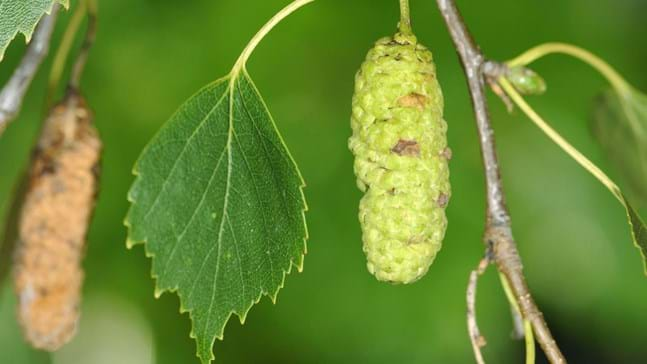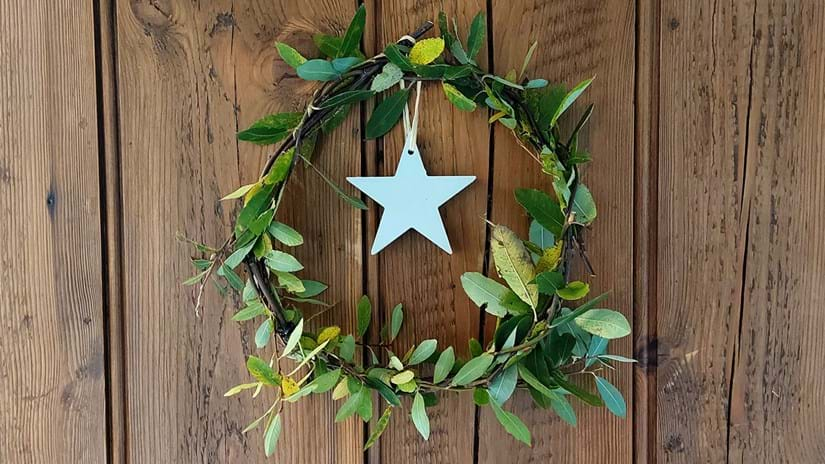
Credit: Brian Legg / WTML
Leaves
Light green, small and triangular-shaped with a toothed edge, which fade to yellow in autumn.
Pretty, pale, a symbol of purity. This common tree, with its silver-white bark, is favoured by gardeners who want to renew and purify their land for coming year.
Common name: silver birch
Scientific name: Betula pendula
Family: Betulaceae
Origin: native
Silver birch is a striking, medium-sized deciduous tree. When mature they can reach 30m in height, forming a light canopy with elegant, drooping branches. The white bark sheds layers like tissue paper and becomes black and rugged at the base. As the trees mature, the bark develops dark, diamond-shaped fissures. Twigs are smooth, and have small dark warts.
Look out for: its bark, which is white, and its triangular-shaped leaves.
Identified in winter by: bark that is white year-round and twigs that are rough to the touch.

Credit: Brian Legg / WTML
Light green, small and triangular-shaped with a toothed edge, which fade to yellow in autumn.

Credit: Ashley Cooper / Alamy Stock Photo
Silver birch is monoecious, meaning both male and female flowers (catkins) are found on the same tree, from April to May. The flowers appear from April to May. Male catkins are long and yellow-brown in colour, and hang in groups of two to four at the tips of shoots, like lambs' tails. Female catkins are smaller, short, bright green and erect.

Credit: Nature Photographers Ltd / WTML
After successful pollination (by wind), female catkins thicken and change colour to a dark crimson. Masses of tiny seeds are borne in autumn and dispersed by the wind.
Downy birch (Betula pubescens) and the two easily hybridise. New shoots on the silver birch are hairless and warty whereas those of downy birch are smooth and covered in soft hairs.

Have you noticed buds bursting into leaf or fruit ripening in the hedgerows? Tell us what's happening to the trees around you and help scientists track the effects of climate change on wildlife.
Take part in our Nature's Calendar surveySilver birch is a popular garden tree and often hybridises with our other native birch, the downy birch, Betula pubescens, which is more common in Scotland. Tolerant of a range of temperatures, it grows as far south as Spain and as far north as Lapland. It thrives in dry woodlands, downs and heaths.
Silver birch can be used to improve soil quality. Its widely spread roots bring otherwise inaccessible nutrients into the tree, which are recycled on to the soil surface when the tree sheds its leaves.
Birch woods (which may include downy or silver birch, or both) have a light, open canopy, providing the perfect conditions for grasses, mosses, wood anemones, bluebells, wood sorrel and violets to grow.
Silver birch provides food and habitat for more than 300 insect species – the leaves attracting aphids which provide food for ladybirds and other species further up the food chain. The leaves are also a food plant for the caterpillars of many moths, including the angle-shades, buff tip, pebble hook-tip, and Kentish glory. Birch trees are particularly associated with specific fungi, including fly agaric, woolly milk cap, birch milk cap, birch brittlegill, birch knight, chanterelle and the birch polypore (razor strop).
Woodpeckers and other hole-nesting birds often nest in the trunk, while the seeds are eaten by siskins, greenfinches and redpolls.

Credit: Laurie Campbell / WTML
In early Celtic mythology, the birch symbolised renewal and purification. Bundles of birch twigs were used to drive out the spirits of the old year, and gardeners still use the birch besom, or broom, to 'purify' their gardens. It is also used as a symbol of love and fertility. In Scottish Highland folklore, a barren cow herded with a birch stick would become fertile, and a pregnant cow would bear a healthy calf.

Credit: Phil Formby / WTML
Birch wood is tough and heavy, making it suitable for furniture production, handles and toys. It was once used to make hardwearing bobbins, spools and reels for the Lancashire cotton industry. The bark is used for tanning leather. Silver birch wood is of little commercial value in Britain because the trees don’t grow as large as they do in other parts of Europe.

Helen Keating • 05 Dec 2022
Transform your home into a woodland wonderland this Christmas with our easy ideas for festive, foraged home decor.
Be inspiredPlanted birch appears to be susceptible to birch dieback, which is caused by two fungal pathogens – Marssonina betulae and Anisogramma virgultorum. Naturally regenerated birch (grown from seed fallen from a tree) appears to be less prone to this disease.